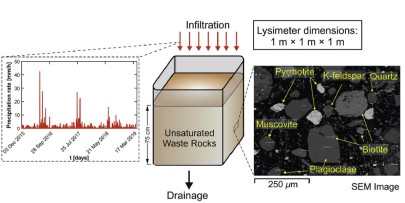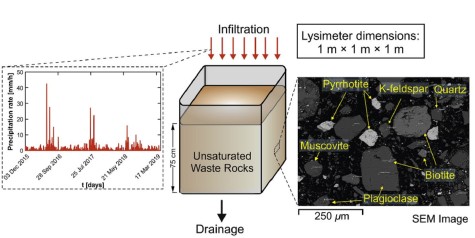Subsurface/atmosphere interactions
The exchange of mass, momentum and energy between the subsurface and the atmosphere has significant environmental and climatic implications. Such exchange phenomena control the dynamics of biogeochemical processes, greenhouse gas emissions to the atmosphere, and pore water quality. We study the interactions between these physical and biogeochemical processes in coupled porous media/free-flow systems by developing innovative experimental systems and combining different theoretical concepts (fluid mechanics, multi-continuum approaches, multiphase flow and reactive transport). Our ultimate goal is to understand how biogeochemical subsurface processes respond to climatic-driven atmosphere dynamics.
Key publications on this topic:
Ahmadi N., Muniruzzaman M., Sprocati R., Heck K., Mosthaf K., & Rolle M. (2022). Coupling soil/atmosphere interactions and geochemical processes: A multiphase and multicomponent reactive transport approach. Advances in Water Resources, 169, 104303. DOI
Ahmadi N., Acocella M., Fries E., Mosthaf K. & Rolle M. (2022). Oxygen propagation fronts in porous media under evaporative conditions at the soil/atmosphere interface: Lab‐Scale experiments and model‐based interpretation. Water Resources Research, 58(6), e2021WR031668. DOI
Ahmadi N., Heck K., Rolle M., Helmig R. & Mosthaf K. (2021). On multicomponent gas diffusion and coupling concepts for porous media and free flow: a benchmark study. Computational Geosciences, 25, 1493-1507. DOI
- Multiphase and multicomponent reactive transport in natural and engineering settings
Understanding the spatio-temporal dynamics of flow and transport processes in unsaturated porous media, where multiple fluid phases co-exist and co-evolve is of great importance to quantify the rate of geochemical and biological reactions. We study the interplay between phase evolution and reactive processes in partially saturated porous media using non-isothermal multiphase and multicomponent reactive transport models. In addition to natural soil systems, we use this approach to describe reactive transport processes in engineering settings with waste management applications (e.g., landfills and mining sites).
Key publications on this topic:
Muniruzzaman M., Karlsson T., Ahmadi N., Kauppila P. M., Kauppila T. & Rolle M. (2021). Weathering of unsaturated waste rocks from Kevitsa and Hitura mines: Pilot-scale lysimeter experiments and reactive transport modeling. Applied Geochemistry, 130, 104984. DOI
Muniruzzaman M., Karlsson T., Ahmadi N. & Rolle M. (2020). Multiphase and multicomponent simulation of acid mine drainage in unsaturated mine waste: modeling approach, benchmarks and application examples. Applied Geochemistry, 120, 104677. DOI
Ahmadi N., Mosthaf K., Scheutz C., Kjeldsen P. & Rolle M. (2020). Model-based interpretation of methane oxidation and respiration processes in landfill biocovers: 3-D simulation of laboratory and pilot experiments. Waste Management, 108, 160-171. DOI
Electrokinetic (EK) techniques rely on the application of electric fields to enhance species mobility in porous media and have a great potential in many fields of science and engineering, including soil and groundwater remediation and recovery of metals for sustainable mining activities. In the context of remediation of contaminated sites, electrokinetic remediation is a promising technology that uses a low-intensity electric field, applied in the subsurface, to mobilize and remove both organic and inorganic contaminants from low-permeability soils and sediments and/or to enhance the delivery of amendments. The design, optimization and control of EK systems require a comprehensive and quantitative understanding of the complex interplay between physical, chemical, electrostatic and biogeochemical processes. We develop innovative multi-dimensional experimental setup and modeling tools (e.g., NP-Phreeqc-EK) to investigate EK systems.
Key publications on this topic:
Sprocati R. & Rolle M. (2022), On the interplay between electromigration and electroosmosis during electrokinetic transport in heterogeneous porous media. Water Research, 213, 118161. DOI
Sprocati R., Gallo A., Sethi R. & Rolle M. (2021). Electrokinetic delivery of reactants: pore water chemistry controls transport, mixing and degradation. Environmental Science & Technology, 55, 719-729. DOI
Sprocati R., Masi M., Muniruzzaman M. & Rolle M. (2019). Modeling electrokinetic transport and biogeochemical reactions in porous media: A multidimensional Nernst–Planck–Poisson approach with PHREEQC coupling. Advances in Water Resources, 127, 134-147. DOI
Transport of multicomponent electrolyte solutions in saturated porous media is influenced by the electrostatic coupling between charged species. The proper description of these Coulombic interactions is of great importance since they control the displacement of the different ions in the pore water and remarkably impact mass transfer not only under diffusion, but also under advection-dominated flow regimes. To accurately describe charge effects in flow-through systems, we perform detailed experiments in homogeneous and heterogeneous porous media and we propose innovative reactive transport modeling approaches based on the Nernst-Planck formulation of diffusive and dispersive fluxes.
Key publications on this topic
Rolle M., Sprocati R., Masi M., Jin B. & Muniruzzaman M. (2018). Nernst‐Planck‐based description of transport, Coulombic interactions, and geochemical reactions in porous media: Modeling approach and benchmark experiments. Water Resources Research, 54(4), 3176-3195. DOI
Muniruzzaman M. & Rolle M. (2019). Multicomponent ionic transport modeling in physically and electrostatically heterogeneous porous media with PhreeqcRM coupling for geochemical reactions. Water Resources Research, 55, 11121-11143.DOI
Muniruzzaman M. & Rolle M. (2017). Experimental investigation of the impact of compound-specific dispersion and electrostatic interactions on transient transport and solute breakthrough. Water Resources Research, 53(2), 1189-1209. DOI
Groundwater contamination by PFAS is an environmental problem of increasing concern due to the widespread use, mobility and persistence of these organic compounds. We perform detailed experimental and modeling investigation to elucidate and quantify PFAS sorption mechanisms at mineral/water interfaces under dynamic hydrochemistry conditions. Specifically, we have recently focused on the interactions between PFOS and goethite in batch and flow-through systems and we have combined insights from sorption experiments, IR spectroscopy analysis and surface complexation modeling.
Key publications on this topic
Cogorno, J., & Rolle, M. (2024a). Impact of Variable Water Chemistry on PFOS-Goethite Interactions: Experimental Evidence and Surface Complexation Modeling. Environmental Science & Technology, 58(3), 1731-1740.DOI
Cogorno, J., & Rolle, M. (2024b). Multicomponent and Surface Charge Effects on PFOS Sorption and Transport in Goethite-Coated Porous Media under Variable Hydrochemical Conditions. Environmental Science & Technology, 58(31), 13866-13878. DOI
The presence of chemical heterogeneities (e.g., reactive minerals) and their spatial distribution in subsurface environments affect important biogeochemical processes such as dissolution and precipitation reactions, as well as the release and transport of toxic elements like heavy metals and metalloids. We investigate the impact of chemical heterogeneities on groundwater quality, particularly under redox-dynamic conditions induced by anthropogenic forcing (e.g., managed aquifer recharge) and natural processes. .
Key publications on this topic
Battistel M., Stolze L., Muniruzzaman M. & Rolle M. (2021). Arsenic release and transport during oxidative dissolution of spatially-distributed sulfide minerals. Journal of Hazardous Materials, 409, 124651. DOI
Battistel M., Muniruzzaman M., Onses F., Lee J. & Rolle M. (2019). Reactive fronts in chemically heterogeneous porous media: Experimental and modeling investigation of pyrite oxidation. Applied Geochemistry, 100, 77-89.DOI
Fakhreddine S., Lee J., Kitanidis P.K., Fendorf S. & Rolle M. (2016). Imaging geochemical heterogeneities using inverse reactive transport modeling: An example relevant for characterizing arsenic mobilization and distribution. Advances in Water Resources, 88, 186-197. DOI
- Contaminant biodegradation and isotope fractionation
Biodegradation of organic contaminants (e.g., petroleum hydrocarbons and chlorinated ethenes) in subsurface environments is controlled by various physical and transformation processes. Understanding the interaction between these processes is challenging since physical processes can act as a rate-limiting step and consequently impose controls on the overall rate of contaminant degradation. Compound-specific isotope analysis is widely used in contaminant hydrology to identify pollution sources and to provide evidence of contaminant degradation. We study contaminant biodegradation and isotope fractionation with the aim of elucidating the complex interplay between physical transport and biological processes and of providing improved modeling tools to interpret biodegradation and isotope fractionation in natural and engineered systems.
Key publications on this topic
Wienkenjohann H., Jin B. & Rolle M. (2023). Diffusive‐dispersive isotope fractionation of chlorinated ethenes in groundwater: The key role of incomplete mixing and its multi‐scale effects. Water Resources Research, 59(4), e2022WR034041.DOI
Murray A.M., Maillard J., Jin B., Broholm M., Holliger C. & Rolle M. (2019). A modeling approach integrating microbial activity, mass transfer, and geochemical processes to interpret biological assays: An example for PCE degradation in a multi-phase batch setup. Water Research, 160, 484-496. DOI
Jin B. & Rolle M. (2016). Joint interpretation of enantiomer and stable isotope fractionation for chiral pesticides degradation. Water Research, 105, 178-186. DOI
Arsenic geogenic contamination of groundwater represents a global threat to the health of millions of people in different parts of the world. Therefore, the understanding of the processes governing the release and transport of arsenic in groundwater systems is of pivotal importance. The interaction between arsenic and iron minerals is one of the key processes controlling As mobility in such systems. We combine flow-through experiments with reactive transport and surface complexation modeling to gain a better understanding of arsenic fate and transport in groundwater by explicitly assessing the coupling between surface and solution chemistry, electrostatic interactions and mass transfer processes.
Key publications on this topic
Stolze L., Battistel M. & Rolle M. (2022). Oxidative dissolution of arsenic-bearing sulfide minerals in groundwater: Impact of hydrochemical and hydrodynamic conditions on arsenic release and surface evolution. Environmental Science & Technology, 56(8), 5049-5061. DOI
Stolze L., Zhang D., Guo H. & Rolle M. (2019). Surface complexation modeling of arsenic mobilization from goethite: Interpretation of an in-situ experiment. Geochimica et Cosmochimica Acta, 248, 274-288.DOI
Stolze L., Zhang D., Guo H. & Rolle M. (2019). Model-based interpretation of groundwater arsenic mobility during in situ reductive transformation of ferrihydrite. Environmental Science & Technology, 53(12), 6845-6854. DOI
Mixing processes significantly control reactive solute transport in the subsurface. For instance, natural attenuation and in situ remediation of contaminant plumes in groundwater are often limited by the availability of one or more reactants, brought into contact by physical mixing. The extent of mixing strongly depends on the topology of the flow field and its complex structure, on subsurface heterogeneity, and on the diffusive/dispersive properties of transported solutes. We study mixing and mixing-controlled reactions at relavant scales for subsurface applications (i.e., pore, laboratory and field scales) and propose innovative flow-through experiments and modeling approaches to understand and quantify mixing in porous media.
Key publications on this topic
Rolle M. & Le Borgne T. (2019). Mixing and reactive fronts in the subsurface. Reviews in Mineralogy and Geochemistry, 85, 111-142. DOI
Ye Y., Chiogna G., Cirpka O. A., Grathwohl P. & Rolle M. (2015). Experimental evidence of helical flow in porous media. Physical Review Letters, 115(19), 194502. DOI
Rolle M. & Kitanidis P.K. (2014). Effects of compound-specific dilution on transient transport and solute breakthrough: A pore-scale analysis. Advances in Water Resources, 71, 186-199. DOI
In many countries of the Northern Hemisphere, upper geological layers contain glacial deposits, such as clayey tills, which often constitue the only natural protection against contaminant leaching from the surface into groundwater bodies. However, pesticides and other contaminants have been frequently detected in aquifers beneath such geological layers, which threaten groundwater quality and drinking water wells. Therefore, the investigation of solute transport in fractured clayey tills is of pivotal importance to assess the vulnerability of groundwater aquifers. We perform large undisturbed column (LUC) experiments, field investigation and discrete-fracture-matrix (DFM) numerical modeling for a detailed analysis of flow and transport processes in fracturedclayey tills.
Key publications on this topic
Aamand J., Badawi N., Jakobsen P.R., Jørgensen P.R., Mosthaf, K., Troldborg L. & Rolle M. (2022). Mapping groundwater vulnerability to pesticide contamination through fractured clays: CLAYFRAC. Danish EPA. DOI
Mosthaf K., Rolle M., Petursdottir U., Aamand J. & Jørgensen P.R. (2021). Transport of tracers and pesticides through fractured clayey till: large undisturbed column experiments and model‐based interpretation. Water Resources Research, 57(5), e2020WR028019, DOI
Jørgensen P.R., Mosthaf K. & Rolle M. (2019). A large undisturbed column method to study flow and transport in macropores and fractured media. Groundwater, 57(6), 951-961, DOI





















